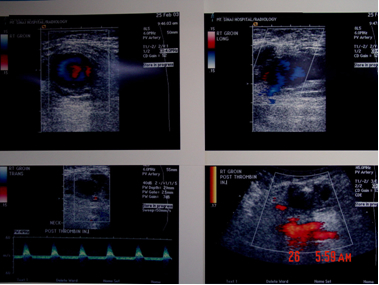An arterial pseudoaneurysm is a false sac that develops adjacent to an artery under its pulsatile influence, often after trauma to the artery. This includes arterial punctures. The wall of a pseudoaneurysm is not true (which is why it is called a false (or pseudo) aneurysm), being comprised of blood clot and compressed tissue, which explains why pseudoaneurysms may expand with time and cause symptoms.
When a pseudoaneurysm is diagnosed one of five treatment options are available: doing nothing, if the aneurysm is small; applying sustained pressure over its neck (that is the track connecting it to the native vessel) until it closes, also if it is a small pseudoaneurysm; repair it surgically; embolizing it with coils; injecting soluble thrombin into it under real-time ultrasound guidance, if it is reachable. More and more people now choose the last option to treat large symptomatic pseudoaneurysms that complicate arterial punctures because it is quick, simple to perform, and relatively safe.
The images below show how I occluded a pseudoaneurysm of the right common femoral artery in a woman who developed one after cardiac catheterization.
The top 2 images show turbulent blood flow in the sac of the pseudoaneurysm, which in the second top image is shown to have a short narrow neck (the blue color below the turbulent sac) demonstrated to connect it to the right common femoral artery. The absence of turbulence in the 2 bottom row images means that the sac is thrombosed; the bright red color behind the sac in the lower second image is the common femoral artery, proving that it was not occluded during thrombin injection into the sac.




